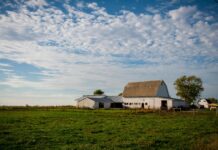By SUSAN MYKRANTZ
Contributing Writer
SMITHVILLE, Ohio — Tradition is a bigger predator concern for the sheep industry than coyotes, according to Charles Parker, retired chairman of the Department of Animal Science at The Ohio State University. Parker told shepherds attending the 2010 Ohio Heartland Sheep Improvement Association annual meeting that sheep have a lot to offer.
“Sheep are in harmony with nature and naturally utilize as much solar energy as any other animal and can exist on 90 percent of the vegetation found in any region of the world,” he said. “Sheep are great for retirees, they add aesthetics to the landscape — lambs on pasture make a peaceful picture.”
But, he said, at the same time the industry needs to change the way it thinks and produce a consistent, quality product to meet the consumers’ needs. Parker said producers should think about other livestock species programs.
Problem
The biggest challenge facing the industry is that sheep numbers have declined about 85 percent over the past century. In 1865, Ohio had 8 million head of sheep, but by 2000, the state had lost about half their breeding ewes and was down to about 128,000 sheep.
In fact, U. S. sheep numbers have dropped from 54 million in 1942 to fewer than 6 million today. In 2007 there were 83 million U.S. farms with sheep flocks, and 94 percent of those flocks had fewer than 100 head.
“Inventory is a concern,” Parker said. “It needs to change or we will lose our infrastructure. It needs to change so that you will make a profit.”
Change needed
Over the past 50 years, other species of livestock have greatly improved their productivity, while the productivity in sheep has only shown a slight increase.
“Where have we been that we have not been able to double the number of lambs produced per ewe?” he said. “We need to get serious about production. If the ewes produce more lambs, this will lower the feed costs per ewe.”
Parker said producers need to select ewes that will lamb easily and produce vigorous lambs.
Lamb size
Producers also need to look at how big they are getting their sheep. They need to look at the size of the lambs at weaning and how fast the lambs are growing to hit the market.
“Show lambs are fine, but don’t confuse pretty sheep with high performance sheep,” he said.
Producers also need to understand animal behavior and communicate with the sheep, according to Parker. “You need to train them to do what you want and reward them when they do,” he said.
Award winners
Tradition is not a word that applies to the association’s Meritorious Service Award recipients, Jim and Deb Morris of Shreve, Ohio. The Morrises got started in the sheep business in 1997 with the purchase of 29 Polypay sheep.
Today, they raise a flock of 120 crossbred ewes on 77 acres, 50 acres of which is cropland. They have 17 acres of pasture and 14 acres of hay, which can be used as pasture if needed. The pastures are a mix of fescue, orchard grass and trefoil. Their hayfields are a mix of alfalfa and orchard grass.
Sheep
Their flock has a base of Polypay, old style Dorset, Southdown and Dorpers, crossed with a Ile-De-France ram. This is a small, meat-type breed from France that will breed out of season, an important trait for the niche market they have developed for their lambs.
The Morrises lamb three times a year, aiming for the Christmas and Easter markets and summer.
“We want a smaller, meatier ewe that will lamb out of season,” Jim said. “We market our lambs at Mount Vernon as roasters at about 40 to 60 pounds. They average about 47 pounds.”
Goal
The Morrises said that their goal is to improve the genetics in their flock to increase the number of twins born during each lambing cycle and to improve the mothering ability of the ewes to allow them to raise twins.
They also want to improve their pastures to allow them to graze their flock year-round.
Last year, the OHSIA sponsored programs on pasture management and health and nutrition; a lamb-cooking demonstration and educational display at the Wayne County Fair; a farm tour to sheep operations in Knox and Morrow counties; its annual banquet; and a one-day lambing school.
This year, they are sponsoring a series of programs on marketing beginning April 15, with an overview on marketing.
The second program will be April 29 dealing with grass finishing, direct marketing, Internet and farmers markets.
Other programs scheduled for the fall include sessions on roaster and specialty lamb markets, ethnic markets and traditional lamb markets.
The programs will be at Applewood Village Community Center on the campus of the OSU/ATI and will run from 7 to 9 p.m. The cost is $5 for OHSIA members and $10 for nonmembers.
Officers elected were Kathy Bielek, president; Russ Johnson, vice president; and Suzie Gortner, secretary/treasurer.









